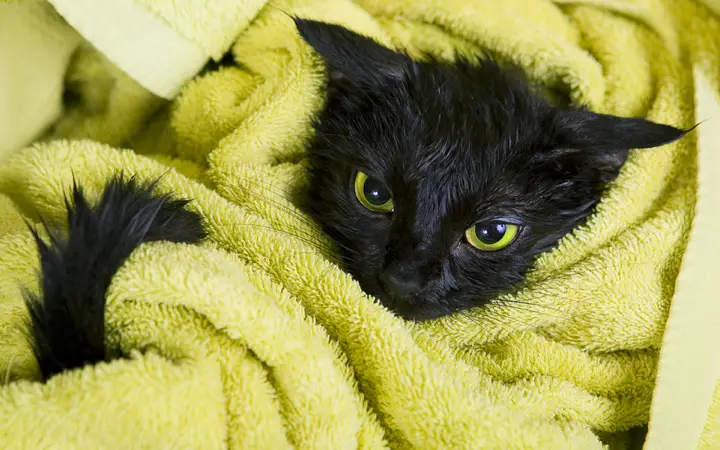By Lisa M. Gerry From The Daily Cat
Since cats aren’t generally known for their love of water, it’s a good thing they don’t need to be cleaned as regularly as dogs. The reason is because cats fastidiously clean themselves with their tongues and teeth on a daily basis.
Most of the time, brushing your cat will be enough to keep him clean, but on occasion — like if your cat has gotten into something particularly dirty, or you’re trying to eliminate excess dander — little Fluffy might need to take a dip in the tub.
In those cases, here are some tips for making the experience less traumatic for you and your furry friend.
Be prepared. When giving your cat a bath, the quicker you can make the experience go by, the better. Have a plastic pitcher or large cup, a towel, a washcloth and cat shampoo at the ready. Also, the ASPCA recommends trimming your cat’s nails prior to bathing him if you’re concerned about scratching. You should also brush your cat thoroughly before bathing him to remove all excess hair and mats ahead of time.
Set the scene. Fill a sink, basin or tub with several inches of lukewarm water. Keep in mind that your cat probably will try to claw her way out of wherever you’re washing her, so try confining her to a space that’s not as easy for her get out of, like a tub with glass doors. If you have access to a spot with a retractable spray nozzle, even better. Test the water, just as you would for a child or baby, to make sure it’s not too hot or cold.
Be steady and confident. If you’re nervous, your cat will sense that and be  nervous as well. When you’re ready, place your cat in the water and wet him from his neck to his tail using water from the pitcher. Don’t pour water on your cat’s face, and do not dunk his entire body into the water all at once. Not only will he hate it, but you run the risk of getting water in his ears and/or nose. Instead, use a damp washcloth once the cat is out of the bath to gently wipe off his face.
nervous as well. When you’re ready, place your cat in the water and wet him from his neck to his tail using water from the pitcher. Don’t pour water on your cat’s face, and do not dunk his entire body into the water all at once. Not only will he hate it, but you run the risk of getting water in his ears and/or nose. Instead, use a damp washcloth once the cat is out of the bath to gently wipe off his face.
Lather up. Clean your cat’s fur with specially formulated feline shampoo, since human shampoo can be too drying for cats’ sensitive skin. Be sure to pay attention to the specific product’s instructions. Again, avoid your cat’s face, especially his nose, ears and mouth. Use the pitcher or cup to rinse off the soap. Since cats clean themselves with their tongues, be sure to get rid of all the suds so that they don’t ingest too much of the shampoo later. Be sure to check under his chin, paws and belly for any residual bubbles.
Dry him quickly. Wrap your cat in a soft towel and dry off his fur as much as you can. For long-haired cats, you may need to brush or comb their fur to get out tangles.
Give your little bud lots of praise — and a treat! — for being so brave. Who knows, your cat might be one of the few that likes baths or, at the very least, will stoically endure them.
If you know your cat is extremely anxious or water-adverse, be sure to consult your vet first. And if your cat absolutely will not tolerate being submerged in water, consider having him professionally cleaned at either a groomer or at the vet.
Do you give your cat a bath? If so, do you find it difficult?

